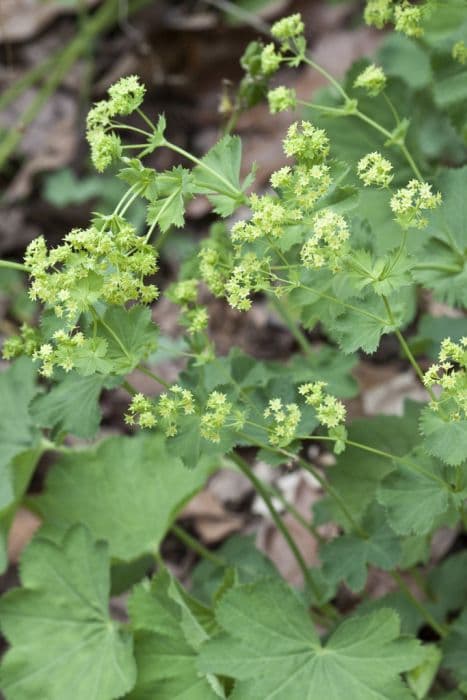Saint Edmund's Pippin Malus domestica 'Saint Edmund's Pippin' (D)

ABOUT
The 'Saint Edmund's Pippin' is a cultivated variety of apple tree known for its distinctive fruit. This apple tree produces apples that are particularly noted for their rich and aromatic flavor, making them a favorite for many apple enthusiasts. The fruit themselves are medium-sized and have a somewhat flattened shape. They are usually greenish-yellow in color with a hint of russet, primarily around the stem, giving them a rustic appearance that distinguishes them from the brighter, more uniformly colored supermarket varieties. As the season progresses, the green skin might acquire a warm golden hue, sometimes with blushes of red if exposed to ample sunlight. The apples have a firm and dense flesh, bearing a fine texture and known to be juicy when bitten into. The flavor is complex, balancing both sweetness and acidity, with subtle undertones that can remind one of pear or nuts, contributing to its overall rich taste profile. The tree itself is adorned with dark green leaves that are oval in shape and have a slightly serrated edge. During the blooming period, it produces beautiful blossoms that are typically white with a flush of pink. The blossoms are not only attractive, but they also have a pleasant fragrance which adds to the sensory experience of the tree in spring. After pollination, these blossoms gradually give way to the formation of the apples, which mature later in the season, developing their unique taste and appearance. The bark of the tree is typically grey and becomes more textured and rugged as the tree matures. As a cultivated variety of apple, 'Saint Edmund's Pippin' may require specific growing conditions and care to thrive and produce its characteristic fruit. It's often recommended for the high-quality apples it yields, which are well-suited for fresh eating as well as culinary uses, thanks to their exceptional flavor and texture.
About this plant
 Names
NamesFamily
Rosaceae
Synonyms
Saint Edmund's Pippin, St. Edmund's Pippin
Common names
Malus domestica 'Saint Edmund's Pippin'.
 Toxicity
ToxicityTo humans
The plant commonly known as apple (for Malus domestica 'Saint Edmund's Pippin') is generally not toxic to humans when the fruit is consumed. However, the seeds of the apple contain amygdalin, which can release cyanide when chewed and digested. Ingesting a significant amount of apple seeds could potentially lead to cyanide poisoning, with symptoms such as headache, confusion, anxiety, shortness of breath, and potentially death if consumed in extremely large quantities. It is important to note that accidental ingestion of a few apple seeds is typically not harmful due to the low concentration of cyanide released and the body's ability to detoxify small amounts of cyanide.
To pets
The apple, when referencing Malus domestica 'Saint Edmund's Pippin', is not poisonous to most pets when the flesh of the fruit is consumed. Similar to humans, the seeds contain amygdalin, which can be harmful if ingested in large quantities. When a pet chews and digests apple seeds, the amygdalin can release cyanide. In small amounts, this is typically not a concern, but if a pet consumes a large quantity of apple seeds, they could experience symptoms of cyanide poisoning. These symptoms may include dilated pupils, difficulty breathing, panting, shock, and in severe cases, even death. Pet owners should thus be cautious and avoid giving their pets the core of an apple where the seeds are concentrated.
 Characteristics
CharacteristicsLife cycle
Perennials
Foliage type
Deciduous
Color of leaves
Green
Flower color
White
Height
10-15 feet (3-4.5 meters)
Spread
10-15 feet (3-4.5 meters)
Plant type
Tree
Hardiness zones
5
Native area
Asia
Benefits
 General Benefits
General Benefits- Edible Fruits: Produces apples that can be eaten fresh or used in cooking and baking.
- Aesthetic Appeal: Offers ornamental value with its attractive blossoms and fruit.
- Pollinator Friendly: Attracts bees and other pollinators, which is beneficial for garden biodiversity.
- Shade Provider: Mature trees can offer shade in gardens and outdoor living spaces.
- Seasonal Interest: Features spring blossoms, summer foliage, and autumn fruit, providing year-round visual interest.
 Medical Properties
Medical Properties- This plant is not used for medical purposes.
 Air-purifying Qualities
Air-purifying QualitiesThis plant is not specifically known for air purifying qualities.
 Other Uses
Other Uses- Wood Crafting: The wood from apple trees can be carved or turned to create intricate small-scale wood projects, including decorative items or small pieces of furniture.
- Printing Blocks: Historically, the wood from apple trees has been used to make printing blocks for creating printed textiles or wallpaper patterns due to its fine grain and hardness.
- Natural Dyes: The leaves and bark of the apple tree can be used to produce natural dyes for coloring fabric or paper in various shades of brown or yellow.
- Plant Support: Branches or small saplings from apple trees can be used as natural stakes or plant supports in the garden for climbing plants or for supporting young trees.
- Aroma Sachets: Dried apple peels or shavings can be used to make natural aroma sachets which can impart a pleasant fragrance to drawers and closets.
- Flavoring Smoking Chips: Wood chips from apple trees can be used for smoking meats to add a sweet, fruity flavor to barbecued foods.
- Photography: In alternative photography processes, extracts from the apple tree can be used as part of the solution for developing photographs.
- Firewood: Applewood is a high-quality firewood that burns hot and slow, with a pleasant fragrance, ideal for wood stoves and fireplaces.
- Instrument Making: The dense wood of apple trees has occasionally been used in crafting musical instruments such as flutes or small pipes.
- Education: Apple tree growth habits and lifecycle can be used in educational programs to teach about botany, horticulture, and the importance of fruit trees in ecosystems.
Interesting Facts
 Feng Shui
Feng ShuiThe apple tree is not used in Feng Shui practice.
 Zodiac Sign Compitability
Zodiac Sign CompitabilityThe apple tree is not used in astrology practice.
 Plant Symbolism
Plant Symbolism- Love and Temptation: The apple, as a symbol, is often associated with love, temptation, and knowledge, rooted in various mythologies and religious texts such as the story of Adam and Eve in the Christian Bible.
- Immortality and Eternal Youth: In Norse mythology, apples are seen as a fruit that grants eternal youth, highlighting the apple's association with vitality and longevity.
- Peace and Harmony: Gifting apples or apple blossoms can be a sign of peace or a wish for harmony, as it is a fruit that is often shared.
- Wisdom and Knowledge: Across different cultures, apples can represent wisdom, much like the fruit from the Tree of Knowledge that is said to have enlightened Adam and Eve.
 Water
WaterApple trees, like the 'Saint Edmund's Pippin', typically require watering once a week, however, this may vary depending on the climate and soil moisture levels. It is important to provide deep watering, which encourages the roots to grow deeper into the ground, enhancing the tree's stability and drought resistance. A mature tree in the growing season can require about 15-20 gallons per week. During the dormant season, the watering frequency should be reduced to when the soil is dry to a depth of 2 inches or as climate conditions dictate to avoid waterlogging. It's crucial to avoid overhead watering to minimize the risk of fungal diseases.
 Light
LightApple trees, such as the 'Saint Edmund's Pippin', thrive best in full sun conditions, where they can receive a minimum of six hours of direct sunlight daily. The best spot for this apple variety is in an open area, away from taller trees or structures that could cast shade on it. Proper sunlight exposure is essential for fruit production and overall health of the tree.
 Temperature
Temperature'Saint Edmund's Pippin' apple trees flourish in a wide range of temperatures but prefer a temperate climate. They can tolerate winter temperatures as low as -30°F, which means they need a cold period to induce dormancy and ensure a good crop the following season. Ideally, the growing season temperatures should be between 60°F and 75°F for optimal growth. Apple trees can be damaged by late spring frosts, so it is essential to plant them in an area that minimizes frost risk.
 Pruning
PruningPruning is essential for the health and productivity of 'Saint Edmund's Pippin' apple trees. It helps maintain the tree's shape, encourages the growth of fruiting wood, and allows sunlight to penetrate the canopy, which is necessary for fruit ripening. Pruning should be done during the dormant season, typically in late winter before spring growth starts, to remove dead or diseased branches, thin out crowded limbs, and shape the tree. It's often advisable to remove about 20-30% of the previous year's growth to maintain good fruit size and quality.
 Cleaning
CleaningAs needed
 Soil
SoilApple trees like 'Saint Edmund's Pippin' thrive in well-draining, loamy soil with a pH between 6.0 to 7.0. The best soil mix should incorporate organic matter, like compost or aged manure, to improve fertility and drainage. Mulching around the base can also maintain soil moisture and temperature.
 Repotting
RepottingApple trees like 'Saint Edmund's Pippin' are typically not repotted as they are grown in the ground. If grown in containers, young trees may need repotting every 2-3 years to ensure they have enough room for root growth.
 Humidity & Misting
Humidity & Misting'Saint Edmund's Pippin' apple trees are adaptable and do not require specific humidity levels; they grow well in average outdoor humidity. It is important to focus on proper watering and site selection rather than humidity control.
 Suitable locations
Suitable locationsIndoor
Not suited for indoor growth; requires outdoor conditions.
Outdoor
Plant in full sun, ensure well-draining soil, and protect from strong winds.
Hardiness zone
4-8 USDA
 Life cycle
Life cycleThe Saint Edmund's Pippin apple tree begins life as a seed, which when germinated in favorable conditions, grows into a young sapling through the process of seedling emergence. With adequate sunlight, water, and soil nutrients, the sapling grows into a mature apple tree, developing a sturdy trunk, branches, and foliage over several years. This tree blooms in the spring due to increased daylight and temperatures, producing fragrant flowers that attract pollinators. After pollination and flower fading, fruit development starts with tiny apples forming and growing to full size throughout the summer, with the final stage of fruit maturation happening in late summer to fall. These mature apples are then harvested and the tree enters a dormant period in cold weather, conserving energy for the next growing season. If undisturbed by environmental factors or disease, this cycle repeats annually with the tree potentially living and producing fruit for many decades.
 Propogation
PropogationPropogation time
Late winter
The most popular method of propagation for the Malus domestica 'Saint Edmund's Pippin', commonly known as the Saint Edmund's Pippin apple, is through grafting. This process typically takes place in late winter or early spring before new growth begins. In grafting, a scion, which is a cutting from a mature Saint Edmund's Pippin apple tree with desirable characteristics, is cut to have a sloping end. This scion is then joined to a rootstock, which is a young tree or root with a strong root system. The two are joined in such a way that the vascular tissues align, allowing them to grow together. The join is then sealed with grafting tape or wax to protect it from pathogens and prevent drying out. Over time, the grafted joint heals, creating a new apple tree that combines the hardiness of the rootstock with the fruit qualities of the Saint Edmund's Pippin.









